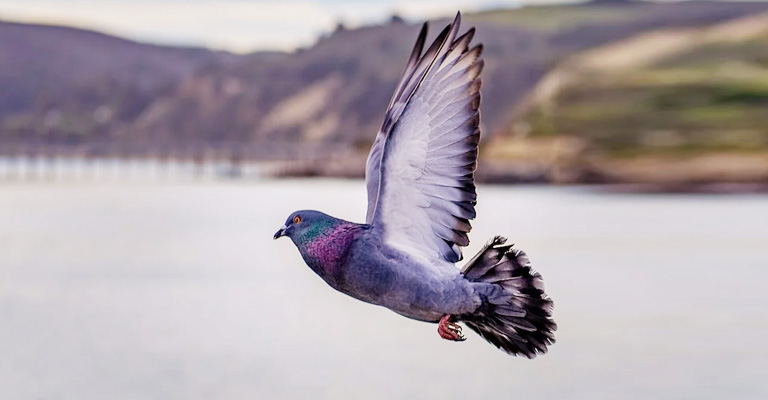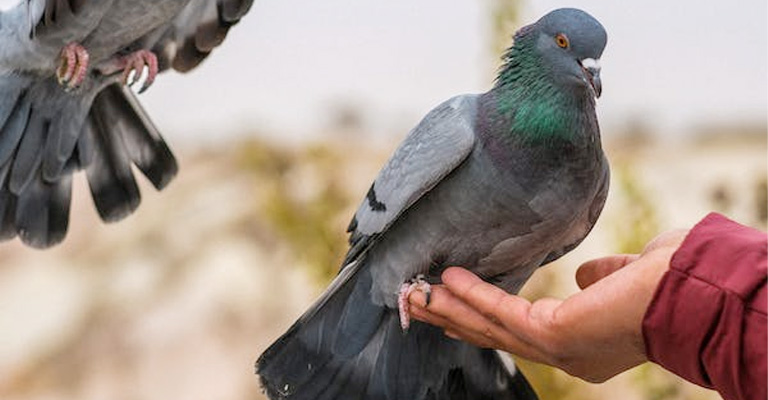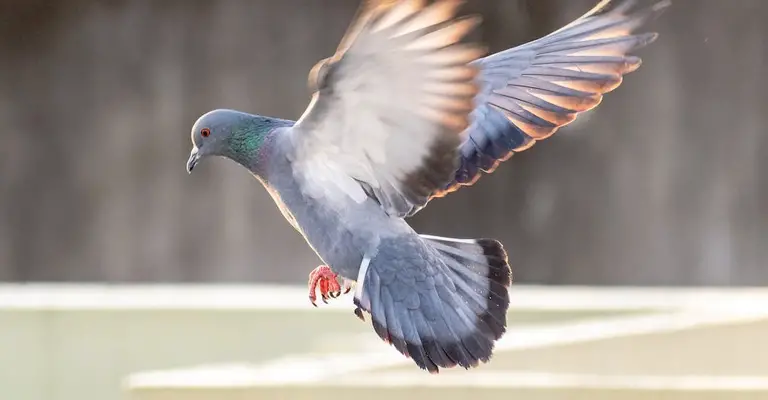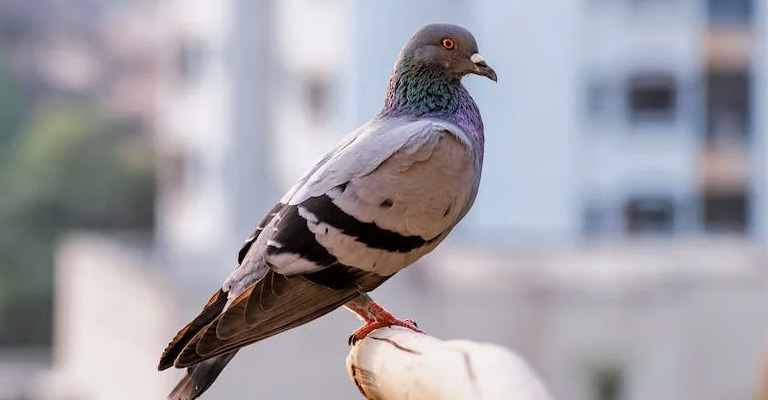For centuries, humans have marveled at the remarkable homing abilities of pigeons. These incredible birds possess an innate sense of direction and can navigate vast distances to return to their home loft.
Whether you’re a hobbyist or an enthusiast, training pigeons to come back home is a rewarding endeavor that allows you to witness nature’s navigation prowess up close.
In this article, we will explore how to train pigeons to come back home and provide you with essential tips to ensure successful results.

How to Train Pigeons to Come Back Home?
If you want your pigeon to come back home, follow the instructions given below:
Understanding the Homing Instinct
Before embarking on training, it’s crucial to understand the homing instinct of pigeons. Homing pigeons possess a natural inclination to return to their loft, driven by an internal compass that enables them to navigate across unfamiliar territories.
Scientists believe this instinct is influenced by a combination of factors, including the Earth’s magnetic field, visual landmarks, and olfactory cues.
Selecting Pigeons
When it comes to homing pigeon training, choosing the right birds is paramount. Opt for healthy, well-bred pigeons that exhibit strong homing instincts.
Look for birds that have a track record of successfully returning home after being released at various distances. Breeders with expertise in homing pigeons can guide you in selecting birds with desirable traits for training.
Creating a Home Loft
A well-designed home loft is essential for creating a safe and comfortable environment for your pigeons. It should be spacious, adequately ventilated, and offer protection from extreme weather conditions.
Ensure that the loft provides ample perching space, nesting areas, and access to food and water. A clean and hygienic environment is crucial for the overall well-being of your pigeons.
Building Trust and Establishing a Bond
Establishing a bond of trust between you and your pigeons is vital. Spend time near the loft, gently interacting with the birds, and hand-feed them regularly.
This process helps them associate your presence with positive experiences, fostering a strong connection. Gradually, the pigeons will become comfortable with your presence and willingly come to you.
Minimum Age for Training Homing Pigeons

The minimum age for training homing pigeons can vary depending on the specific circumstances and the goals of the trainer.
However, it is generally recommended to start training homing pigeons when they are around 6 to 8 weeks old. At this age, young pigeons are capable of flying short distances and have developed some basic flying skills.
Before starting the training process, it’s important to ensure that the pigeons are healthy, properly fed, and have access to clean water.
Additionally, the pigeons should be housed in a suitable loft or coop that provides them with a safe and comfortable environment. Training homing pigeons involves a gradual process of familiarizing them with their surroundings and building up their flying abilities.
This includes short-distance training flights, gradually increasing the distance over time. The pigeons learn to recognize their loft or home as their base and develop the ability to return to it from various locations.
It’s crucial to approach the training process patiently and gradually, allowing the pigeons to develop their homing instincts and navigational skills. The training period can extend over several months before the pigeons are ready for long-distance races or other specialized tasks.
Keep in mind that local regulations or pigeon racing associations may have specific rules and guidelines regarding the minimum age for training homing pigeons.
Therefore, it’s advisable to consult with experienced pigeon fanciers or local authorities for any specific requirements in your area.
Did Pigeons Carry Mails?

Yes, pigeons have a long history of being used to carry messages, often referred to as pigeon posts or pigeon mail.
The practice of using pigeons as messengers date back thousands of years and has been employed by various civilizations throughout history.
Pigeons were particularly valued for their exceptional homing abilities, which made them reliable carriers for delivering messages across long distances.
They were extensively used as a means of communication in different parts of the world, including ancient Egypt, Rome, and Greece. However, the most well-known and widespread use of pigeon mail occurred during the 19th and early 20th centuries.
During this period, pigeon post was used primarily for military purposes and in isolated or hard-to-reach locations. Pigeons were used to relay messages between military outposts, deliver urgent messages during wartime, and provide communication links in areas with limited infrastructure.
One of the most notable examples of pigeon mail is the use of pigeons during World War I and World War II.
Pigeons were carried in small containers or attached to lightweight harnesses and released from aircraft or from the ground to fly back to their home lofts with vital information or requests for assistance.
Pigeons played a significant role in providing a reliable means of communication when traditional methods were unavailable or unreliable.
Their ability to navigate over long distances and return to their home lofts made them valuable messengers in times of need.
Although advancements in technology, such as the development of wireless communication and the telegraph, eventually made pigeon mail obsolete as a mainstream form of communication, the historical significance of using pigeons as messengers cannot be denied.
The legacy of the pigeon post stands as a testament to the remarkable abilities of these birds and their contributions to human communication in the past.
How Do Homing Pigeons Work Out Where To Go?

Homing pigeons have an impressive ability to find their way back to their home loft from distant and unfamiliar locations.
While the exact mechanisms are not fully understood, scientists believe that homing pigeons use a combination of sensory cues to navigate and determine their direction. The main factors that contribute to their homing abilities are as follows:
Earth’s Magnetic Field
Pigeons are believed to possess specialized magnetoreceptors in their brains that allow them to sense the Earth’s magnetic field. This internal compass helps them determine their orientation relative to the Earth’s magnetic poles.
By using this information, pigeons can maintain a general heading in the right direction toward their home loft.
Visual Landmarks
Pigeons are highly skilled at recognizing and memorizing visual landmarks. During training and exploration flights, they build mental maps of their surroundings, allowing them to navigate using familiar visual cues.
These landmarks may include distinctive buildings, geographical features, or other unique structures that help guide them back home.
Sun Compass
Pigeons are diurnal animals, meaning they are active during the day. They use the position of the sun in the sky as an additional navigational reference. The sun’s movement throughout the day helps them adjust their heading to stay on course.
Olfactory Cues
Pigeons have a well-developed sense of smell, and research suggests that they use olfactory cues to recognize familiar scents associated with their home loft. This ability allows them to identify their location relative to their home base.
Familiarity with Home Loft
Pigeons are strongly attached to their home loft, which serves as their haven. They have a natural inclination to return to their familiar roost, and their homing instincts are heightened when they are released from a distant location.
It’s important to note that homing pigeons rely on a combination of these cues to navigate. The interplay between their internal magnetic compass, visual landmarks, sun compass, and olfactory recognition enables them to determine their direction and find their way home.
The accuracy of their homing abilities is remarkable, and it has been a subject of fascination for scientists and enthusiasts alike for centuries.
FAQs
The duration of training pigeons to come back home can vary depending on several factors, including the individual pigeons’ abilities, the training techniques used, and the time devoted to training. Generally, it takes several weeks to a few months to train pigeons to reliably return home from long distances.
Not all pigeons have the same level of innate homing abilities. While pigeons as a species possess a natural inclination to return home, some individuals may exhibit stronger homing instincts than others. To train pigeons effectively, it is advisable to select birds from a reputable breeder with a lineage of successful homing pigeons.
The exact mechanisms behind pigeon navigation are still being studied, but it is believed to be a combination of various factors. Pigeons use a sense of the Earth’s magnetic field to orient themselves, along with visual cues such as landmarks and the position of the sun.
Pigeons may occasionally get disoriented or lost during training, especially when they are still in the early stages of learning. This is why it is important to start with shorter training flights and gradually increase the distance as the pigeons become more experienced.
Homing pigeons require regular care and attention to maintain their health and well-being. They should have access to clean water and a balanced diet consisting of high-quality pigeon feed. The loft should be kept clean and well-ventilated, and periodic health check-ups by a veterinarian are recommended.
Final Words
So, now you know how to train pigeons to come back home. Training pigeons to come back home is a fascinating and rewarding pursuit.
By understanding their natural instincts, establishing a bond, and employing effective training techniques, you can nurture and enhance their homing abilities.
Remember, patience, consistency, and a genuine passion for these remarkable birds are key to success. Enjoy the journey of training and witnessing the awe-inspiring navigation skills of your homing pigeons as they gracefully return to their loft.